| Srl | Item |
| 1 |
ID:
139540
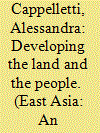

|
|
|
|
|
| Summary/Abstract |
Social development in Xinjiang Uyghur Autonomous Region from 1999 to 2009 is the focus of this article. I will explore the current situation among Uyghurs and Hans living in Xinjiang in different social contexts and purviews, mainly assessing problems and open questions hindering a balanced and consensus-based social development in the area. The concept of “development” per se will be understood with a critical perspective. The fieldwork was conducted in 2011 and 2012 in Urumqi, Turpan, Kahsgar, Wujiaqu and Shihezi, and in eight rural villages—seven located in the Kashgar Prefecture and one in Kizilsu Kyrgyz Autonomous Prefecture. The opportunity to adopt an “insider perspective”, at the same time working with critical tools provided by the disciplines of sociology and anthropology, can be considered an important asset in the field of Xinjiang studies. My PhD research in China (2010–2013) and my work as consultant for KFW (2011–2012) have been of great help in adopting this approach. Interviews, participant observation and analysis of quantitative and qualitative data from different sources are the basis of the fieldwork results presented here. UNDP indicators and indexes are taken as reference in setting and organising data.
|
|
|
|
|
|
|
|
|
|
|
|
|
|
|
|
| 2 |
ID:
103140


|
|
|
|
|
| Publication |
2009.
|
| Summary/Abstract |
The generally accepted narrative for the birth of the modern Uyghur nation suggests that a national ideal for the Uyghur people and the use of the 'Uyghur' ethnonym in the modern context were creations of Soviet bureaucrats in the 1920s that were later promoted among Uyghurs in Xinjiang by Chinese authorities with Soviet sympathies. This article challenges this view by drawing on Uyghur language sources, which demonstrate the agency of Uyghur intellectuals in the creation of the concept of a modern Uyghur nation during the early twentieth century. In examining the activities of Uyghur intellectuals in fostering a modern Uyghur national identity, the article emphasizes the role of anti-colonial sentiments in this movement, thus linking the Uyghur example to post-colonial scholarly arguments about the development of modern national consciousness among formerly colonized peoples around the world.
|
|
|
|
|
|
|
|
|
|
|
|
|
|
|
|
| 3 |
ID:
152346
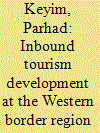

|
|
|
|
|
| Summary/Abstract |
Based on literature review and statistics of National Tourism Administration of China and Xinjiang Uyghur Autonomous Region (XUAR) Tourism Bureau, this article examines the trends of inbound tourism development in the region. The results show that the inbound tourists in the XUAR are only a tiny portion of the Chinese, and the regional total which mainly is made up of domestic tourism originated from the coastal areas. Among the Central Asian countries, Kazakhstan has become the largest inbound tourism market of the XUAR. The article further suggests that it is worth to investigate whether the inbound tourism development of the region is affected by the geopolitical and geo-economic situations and the national strategic interests of respective neighboring countries.
|
|
|
|
|
|
|
|
|
|
|
|
|
|
|
|
| 4 |
ID:
192598
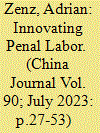

|
|
|
|
|
| Summary/Abstract |
This article argues that China’s campaign of reeducation and forced labor in the Xinjiang Uyghur Autonomous Region through so-called Vocational Skills Education and Training Centers (VSETCs) represents a significant conceptual innovation over prior labor reform. Beijing’s erstwhile penal labor systems treated labor as an integral part of reeducation but suffered from limited reeducation results, low work productivity, and poor resocialization outcomes. In contrast, the VSETC system pragmatically eschews Maoist tenets of labor’s transformational power: its internment camps prioritize intensive reeducation, followed by a process of gradual release into potentially more efficient nonprison enterprises. The resulting potential profitability gains translate into higher economic sustainability—an essential prerequisite for the system’s primary goal of long-term assimilation and coercive integration of resistant ethnic groups into Beijing’s social order. However, VSETC’s and the region’s focus on control and disintegrating ethnic social capital undermines its integrative efforts, replicating a long-standing weakness of prior labor reform.
|
|
|
|
|
|
|
|
|
|
|
|
|
|
|
|
| 5 |
ID:
103144
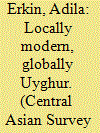

|
|
|
|
|
| Publication |
2009.
|
| Summary/Abstract |
Much scholarship and commentary has raised concerns about the fate of traditional Uyghur culture in the context of development and globalization in the twenty-first century, some even predicting its disappearance through assimilation to mainstream majority Han culture. However, by exploring the modern Uyghur culture of consumption - in foodstuffs, entertainment and real estate - this paper shows an opposite phenomenon: the transformation of the traditional Uyghur culture to a distinct cultural, religious and linguistic popular contemporary Uyghur culture that thrives and expands with the aid of globalization and development.
|
|
|
|
|
|
|
|
|
|
|
|
|
|
|
|
| 6 |
ID:
103673
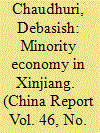

|
|
|
|
|
| Publication |
2010.
|
| Summary/Abstract |
The characteristic feature of the geo-economic space of the People's Republic of China is that 70 per cent of the minority population of the country is concentrated in its western region. The uneven development of the early reform period mostly affected the minority-populated areas. China's westernmost administrative division Xinjiang Uyghur Autonomous Region (XUAR) is one such region which has been restive since 1990 due to an ongoing separatist movement led by Uyghurs, the majority ethnic group of the region. Alongside the regional imbalances in economic development during the reform period, due to geographical as well as historical factors, and long-term policy, a phenomenon of localized economic development has emerged that marginalized the minorities of Xinjiang to a great extent. The paper focuses on the intraregional economic disparities of the region and the economic deprivation of the Uyghurs.
|
|
|
|
|
|
|
|
|
|
|
|
|
|
|
|
| 7 |
ID:
126744
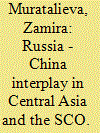

|
|
|
| 8 |
ID:
110610
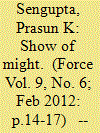

|
|
|
| 9 |
ID:
122451
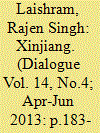

|
|
|
|
|
| Publication |
2013.
|
| Summary/Abstract |
The disquiet in Xinjiang province of the People's Republic of China
(PRC) is becoming acute. A series of events in the recent past attest to
the gravity of the situation and are suggestive of the tenuous Chinese
control in this 'new' frontier province of China. The trajectories of
contest in Xinjiang or Sinkiang appear to be inherent in the frontier
areas of any vast country wherein race, religion, culture and historical
memories impinge. The frontier area, Xinjiang, is a zone "in which all
possible boundaries of geography, race and culture cross and overlap
to form a broad transitional area of great complexity".
1
Xinjiang has
been continually remote from the power centre, with visible patterns of
'incomplete authority' or 'legitimacy crisis' from the central authority.
In addition, the depiction that inhabitants of the frontier areas are
"ethnically different from each empire's ruling elite or majority and
that there was little identification with the central regimes"
2
has
relevance in the case of Xinjiang. An avid writer notes, the history of
Xinjiang is a story of many interactions¯people, cultures and politics¯not
of a single nation but of many overlapping political and social groupings
before the racial or the national categorisation of 'Turkic,' 'Uyghur'
and 'Chinese', which became evident in the twentieth century.
3
|
|
|
|
|
|
|
|
|
|
|
|
|
|
|
|